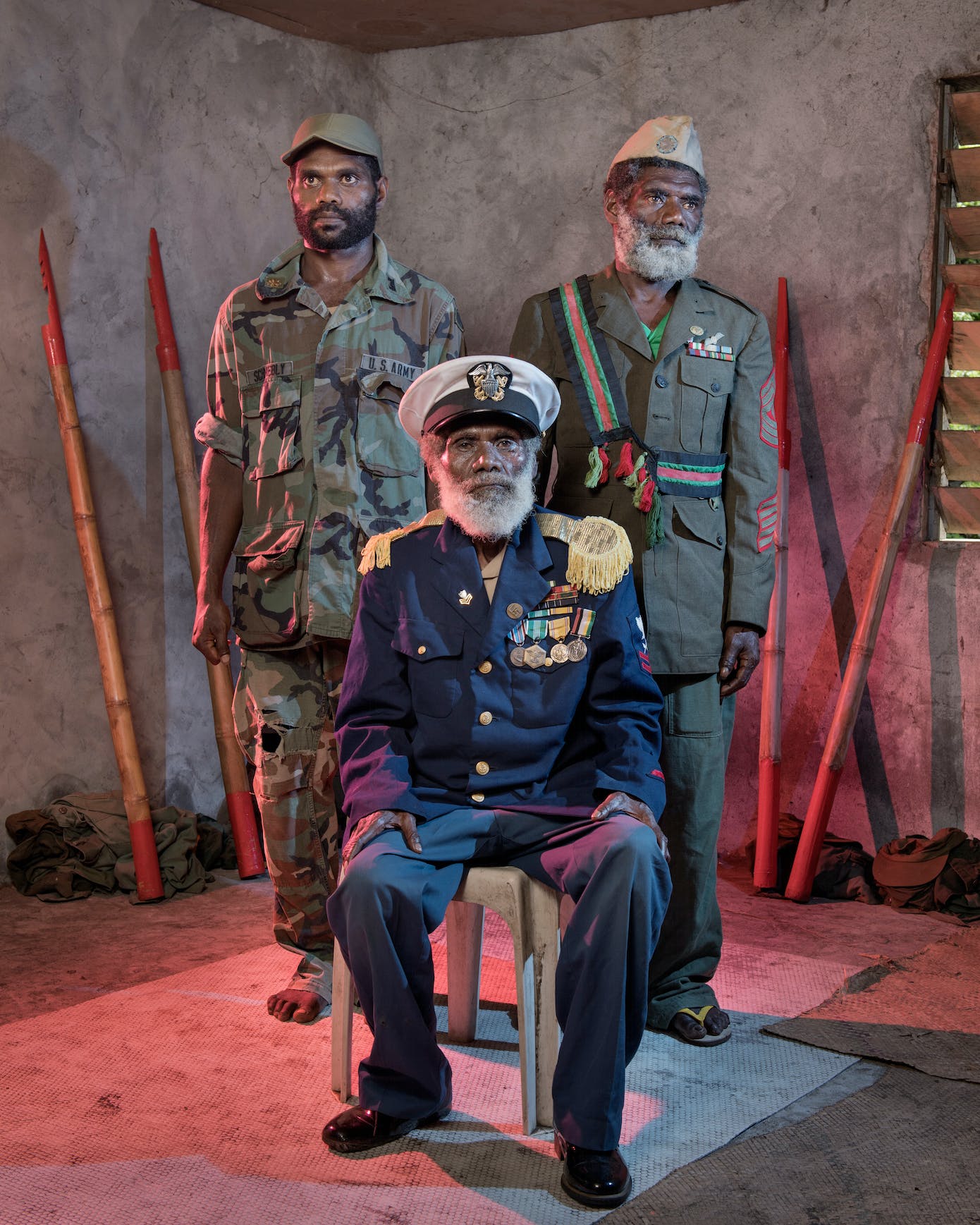John Frum (also called Jon Frum,[1] John Brum,[2] and John Prum[3]) is a mythic figure associated with cargo cults on the island of Tanna in Vanuatu. He is often depicted as an American World War II serviceman who will bring wealth and prosperity to the people if they follow him. Quoting David Attenborough‘s report of an encounter: “‘E look like you. ‘E got white face. ‘E tall man. ‘E live ‘long South America.”[4]
In the 1990s, there was still reportedly over 5,000 members of the John Frum movement but as of 2022 there are less than 500. Now, only the village of Lamakara remains true to the John Frum cause on the island of Tanna. The rest of the island has been mostly converted by Christian missionaries based out of Sulphur Bay.

| Part of a series on |
| Anthropology of religion |
|---|
 |
| Social and cultural anthropology |
John Frum (also called Jon Frum,[1] John Brum,[2] and John Prum[3]) is a figure associated with cargo cults on the island of Tanna in Vanuatu (formerly the New Hebrides). He is often depicted as an American World War II serviceman who will bring wealth and prosperity to the people if they follow him. In a 1960 BBC documentary, British broadcaster David Attenborough asked the locals what Frum looked like and was told "'E look like you. 'E got white face. 'E tall man. 'E live 'long South America."[4]
In the 1990s, there were still reportedly over 5,000 members of the John Frum movement. However, belief in John Frum is in decline; as of 2022, there are fewer than 500 practitioners. Currently, only the village of Lamakara is faithful to the John Frum faith on the island of Tanna. The rest of the island has been mostly converted by Christian missionaries based in Sulphur Bay.[5][better source needed]
History


The religion centering on John Frum arose no later than the late 1930s, when Vanuatu was known as the New Hebrides. The religion may have originated as early as the 1910s, according to a claim in 1949.[2] The movement was influenced by existing religious practice in the Sulphur Bay area of Tanna, particularly the worship of Keraperamun, a god associated with Mount Tukosmera.[6]
In one analysis of the cult, the figure was first known as John Broom, who was believed by followers to one day return from a distant land to sweep away the White colonials and return riches to the islands.[7] In some versions of the story, a native man named Manehivi, using the alias "John Frum", began appearing among the native people of Tanna dressed in a Western-style coat, assuring the people he would bring them houses, clothes, food, and transport.[2][8]
Others contend that John Frum was a spirit vision induced by kava, a plant with mild psychoactive properties.[9] Said to be a manifestation of Keraperamun, this John Frum promised the dawn of a new age in which all White people, including missionaries, would depart the New Hebrides, leaving behind their goods and property for the native Melanesians. For this to happen, however, the people of Tanna had to reject all aspects of European society including money, Western education, Christianity and work on copra plantations, and they had to return to traditional kastom (the Bislama language word for customs).
In 1941, followers of John Frum rid themselves of their money in a frenzy of spending, left the missionary churches, schools, villages and plantations, and moved inland to participate in traditional feasts, dances and rituals. Most followers had come from the Presbyterian church.[10] European colonial authorities sought to suppress the movement, at one point arresting a Tannese man calling himself John Frum, humiliating him publicly, imprisoning and ultimately exiling him along with other leaders of the cult to another island in the archipelago.[11][12][13]
Despite this effort, the movement gained popularity in the early 1940s after 50,000 American troops were stationed in Vanuatu during World War II, bringing with them an enormous amount of supplies (or "cargo").[14] During the war, approximately 10,000 Ni-Vanuatu men served in the Vanuatu Labor Corps, a labor battalion of the United States Armed Forces. They provided logistical support to the Allied war effort during the Guadalcanal campaign. The mass participation of Ni-Vanuatu men in the Labor Corps had a significant effect on the John Frum movement, giving it the characteristics of a cargo cult.[15]
After the war and the departure of the Americans, followers of John Frum built symbolic landing strips to encourage American airplanes to land and bring them "cargo". Versions of the cult emphasizing the American connection interpret "John Frum" as a corruption of "John from (America)" (although it could mean "John from" anywhere not of Vanuatan origin).
In 1957, a leader of the John Frum movement, Nakomaha, created the "Tanna Army", a non-violent ritualistic society that organised military-style parades of men with faces painted in ritual colours and wearing white T-shirts with the letters "T-A USA" (Tanna Army USA). This parade takes place every year on February 15, the date on which followers believe John Frum will return, and which is observed as "John Frum Day" in Vanuatu.
In the late 1970s, John Frum followers opposed the imminent creation of an independent united nation of Vanuatu. They objected to a centralised government they feared would favor Western modernity and Christianity that would be detrimental to local customs. The John Frum movement has its own political party, Nagriamel, led by Song Keaspai. The party celebrated its 50th anniversary on February 15, 2007. Chief Isaak Wan Nikiau, its leader, was quoted by the BBC from years past as saying that John Frum was "our God, our Jesus" and would eventually return.[16]
In December 2011, the president of the John Frum movement (and jointly of Nagriamel) was Thitam Goiset, a woman of Vietnamese origin and sister of businessman Dinh Van Than, despite the leadership of these movements having been "previously [...] held by high ranking male chiefs".[17] In 2013, Thitam Goiset was removed from her role as Vanuatu's ambassador to Russia amid evidence of corrupt activities.[18][19]
Followers of the movement continue to celebrate John Frum Day each year in February. Europeans who have made claims of being the leader mentioned in the prophecy—such as Claude-Philippe Berger (d. July 2021), who styled himself the "traditional king of Tanna"—have gained status in Vanuatuan communities by promising to bring development and investment to the communities.[7]
See also
References
- ^ "Jon Frum". jonfrumartfoundation.com. Archived from the original on 21 December 2016. Retrieved 23 June 2017.
- ^ a b c Guiart, Jean (March 1952). "John Frum Movement in Tanna" (PDF). Oceania. 22 (3): 165–177. doi:10.1002/j.1834-4461.1952.tb00558.x. Retrieved 2020-03-07.
- ^ BBC (1991). "The Fantastic Invasion". Event occurs at 34:25. Retrieved 25 July 2020.
- ^ Attenborough, David (1960). People of Paradise. New York: Harper & Brothers.
- ^ Waiting for John Frum: Cargo Cult of the South Pacific | When God is An American Soldier Documentary, 3 May 2021, retrieved 2023-02-07
- ^ Worsley, Peter (1957). The Trumpet Shall Sound: A study of 'cargo' cults in Melanesia. London: MacGibbon & Kee. p. 154.
- ^ a b Lord, Christopher. Photography: Jon Tonks (28 November 2021). "'There was a prophecy I would come': the western men who think they are South Pacific kings". The Guardian. Retrieved 28 November 2021.
- ^ Worsley, The Trumpet Shall Sound, pp. 153–9.
- ^ Tabani, Marc, Une pirogue pour le Paradis : le culte de John Frum à Tanna (Vanuatu). Paris : Editions de la Maison des Sciences de l'Homme, 2008.
- ^ Zocca, Franco (2007). Melanesia and Its Churches: Past and Present. Melanesian Institute. ISBN 9789980650078.
- ^ Geoffrey Hurd et al., Human Societies: An Introduction to Sociology (Boston: Routledge, 1986) p. 74.
- ^ Peter Worsley, From Primitives to Zen, Mircea Eliade ed. (New York: Harper & Row, 1977) p. 415.
- ^ Lamont Lindstrom in Cargo Cults and Millenarian Movements: Transoceanic Comparisons of New Religious Movements G. W. Trompf ed. (New York: Mouton de Gruyter, 1990) p. 244
- ^ Western Oceanian Religions: Jon Frum Movement Archived 2003-10-16 at the Wayback Machine University of Cumbria
- ^ Lindstrom 1991, pp. 49–53.
- ^ "Vanuatu cargo cult marks 50 years". BBC News. 2007-02-15. Retrieved 2007-02-15.
- ^ "Vanuatu appoints ambassador to Russia", Radio New Zealand International, 5 December 2011
- ^ "Vanuatu's ambassador to Russia sacked", ABC News Australia, 23 April 2013.
- ^ "Vanuatu anti-corruption lobby: Russia ambassador a business deal", Radio New Zealand, 16 January 2012.
Bibliography
- Lindstrom, Lamont (1991). "Remembering the Pacific War". Occasional Papers of the Center for Pacific Islands Studies. Center for Pacific Studies: 47–59. ISSN 0897-8905.[dead link]
- Joël Bonnemaison, « Tanna : les hommes lieux (livre 2) » dans Les fondements d'une identité : territoire, histoire et société dans l'archipel de Vanuatu (Mélanésie) : essai de géographie culturelle, ORSTOM Paris, 1988, [lire en ligne [archive]]
- Tabani, Marc. 2008. Une pirogue pour le Paradis : le culte de John Frum à Tanna (Vanuatu) [archive], Paris : Éditions de la Maison des Sciences de l'Homme, 2008.
- Tabani, Marc. 2010. Le culte de John Frum et la tragédie du nouveau millénaire à Tanna (Vanuatu) [archive]. In Douaire-Marsaudon F. et Weichart G. (eds.), Pacific Religiosities. Marseille : Pacific-Credo Publications, 145–172.
- Tabani Marc, Marcellin Abong. 2013. Kago, Kastom, Kalja: the study of indigenous movements in Melanesia today [archive], Marseille, Pacific Credo Publications.
Filmography
- God Is American, feature documentary (2007, 52 min), by Richard Martin-Jordan, on Frum's cult at Tanna
- The Fantastic Invasion, documentary (1991, 59min) by Nigel Randell Evans for the BBC
- Into the Inferno, feature documentary (2016, 107 min), by Werner Herzog, on Tanna's active volcano
Further reading
- Attenborough, D. (1960) Quest in Paradise. Lutterworth Press (reprinted 1963 Pan Books Ltd.)
- Rice, Edward (1974). John Frum He Come: Cargo Cults & Cargo Messiahs in the South Pacific. Garden City: Dorrance & Co. ISBN 0-385-00523-7.
- Huffer, Elise, Grands Hommes et Petites Îles: La Politique Extérieure de Fidji, de Tonga et du Vanuatu, Paris: Orstom, 1993, ISBN 2-7099-1125-6
- Jarvie, I. C. (1964). The Revolution in Anthropology. London: Routledge & Kegan Paul (reprinted 1967) pp. 61–63.
- Lindstrom, L. (1990.) "Big Men as Ancestors: Inspirations and Copyrights on Tanna (Vanuatu)". Ethnology, vol xxix no. 4. October.
- Theroux, P (1992). The Happy Isles of Oceania. Penguin Books ISBN 0-14-015976-2
- Tonks, Jon and Christopher Lord (2021) The Men Who Would Be King. Dewi Lewis ISBN 9781911306436
- Nat. Geographic: May 1974. "Tanna (Island, New Hebrides, South Pacific Ocean) Awaits the Coming of John Frum (cargo cults of Melanesia since about 1940)".
- Raffaele, Paul (February 2006). "In John They Trust". Smithsonian. Archived from the original on February 23, 2009. Retrieved Nov 26, 2009.

